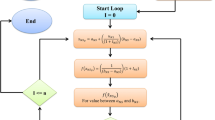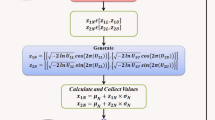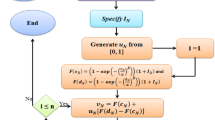Abstract
Objective
This paper aims to introduce an algorithm designed for generating random variates in situations characterized by uncertainty.
Method
The paper outlines the development of two distinct algorithms for producing both minimum and maximum neutrosophic data based on the Weibull distribution.
Results
Through comprehensive simulations, the efficacy of these algorithms has been thoroughly assessed. The paper includes tables presenting neutrosophic random data and an in-depth analysis of how uncertainty impacts these values.
Conclusion
The study's findings demonstrate a noteworthy correlation between the degree of uncertainty and the neutrosophic minimum and maximum data. As uncertainty intensifies, these values exhibit a tendency to decrease.
Similar content being viewed by others
Introduction
Order statistics has been playing important role in many areas including quality control and inference. It is used in ordering the data and used to deal with the application of these ordered data and their related functions. In acceptance sampling plans, the order statistics is used to shorten the failure data and use to improve the robustness of sampling plans [15]. Evans et al. [9] applied the discrete random variable from order statistics in bootstrapping. Shi et al. [16] studied the application of correlated random variables from order statistics at-speed testing. Chen [5] discussed the use of order statistics in various statistical tests and in clinical studies. The order statistics is applied in statistical tests to give minimum variance unbiased estimators. Dytso et al. [8] discussed the application of order statistics in image denoising. Bhoj and Chandra [4] applied the order statistics for skewed distribution. More applications of order statistics can be seen in [1, 10, 12,13,14, 20] discussed that the measurement quantities are not always imprecise. Classical statistics cannot be applied in the presence of imprecise data. Neutrosophic statistics is an extension of classical statistics and is applied when imprecise data is presented [17]. Chen et al. [6, 7] discussed the methods to analyze the neutrosophic data. Aslam [3] proposed an algorithm to generate random variables from the DUS-neutrosophic Weibull distribution. Recently, Florentin [18] proved the efficiency of neutrosophic statistics over interval statistics and classical statistics. Jdid et al. [11] presented generating the random variable method from the uniform distribution.
The existing order statistics methods cannot be applied when imprecise data is presented. According to the best of our knowledge, there is no work on order statistics under neutrosophic statistics. We will introduce neutrosophic order statistics first and then we will design algorithms to generate neutrosophic random numbers. In this paper, we will propose a generator to generate random numbers from neutrosophic statistics. We will present the algorithms to generate minimum neutrosophic data and maximum neutrosophic data from the Weibull distribution. The neutrosophic data will be presented for various measures of indeterminacy to see its effect on neutrosophic data. Based on the simulation study, it is expected the reduction in neutrosophic data as the degree of indeterminacy is increased.
Neutrosophic order statistics
Let \({x}_{N}={x}_{L}+{x}_{U}{I}_{N};{I}_{N}\epsilon \left[{I}_{L},{I}_{U}\right]\) and \({n}_{nN}={n}_{L}+{n}_{U}{I}_{N};{I}_{N}\epsilon \left[{I}_{L},{I}_{U}\right]\) be neutrosophic random variable and neutrosophic sample size, respectively. Note that the first values in both neutrosophic forms present the determinate value (classical statistics) and the second values present the indeterminate part. Rearranging \({n}_{nN}\) neutrosophic sample in ascending order \({x}_{\left(1N\right)},{x}_{\left(2N\right)},{x}_{\left(3N\right)},\dots ,{x}_{\left(nN\right)}\), where \({x}_{\left(iN\right)}\) be the \(ith\) smaller value in \({n}_{nN}\). Let \({y}_{N}\) presents \(ith\) neutrosophic shorted values from \({x}_{\left(1N\right)},{x}_{\left(2N\right)},{x}_{\left(3N\right)},\dots ,{x}_{\left(nN\right)}\) with the following neutrosophic probability density function (npdf):
Let \({y}_{N}\) be a minimum value of the data \({y}_{N}=min\left({x}_{1N},{x}_{2N},{x}_{3N},\dots ,{x}_{nN}\right)\). The npdf of \({y}_{N}\) by following [19] is given by
The ncdf of \({y}_{N}\) is given by:
Suppose that \({w}_{N}\) be the maximum value of the data from NWD. By following [19], the npdf of \({w}_{N}={\text{max}}({x}_{1N},{x}_{2N},{x}_{3N},\dots ,{x}_{nN})\) is given by:
The ncdf of \({w}_{N}\) is given by:
Algorithm to generate minimum neutrosophic value
From [2], the npdf of the neutrosophic Weibull distribution (NWD) is given by.
The neutrosophic cumulative distribution function (ncdf) of the NWD is given by:
Let \(G\left({y}_{N}\right)={u}_{N}\) and \(F\left({y}_{N}\right)={v}_{N}\) in Eq. (4), we have
To generate the neutrosophic minimum data of \({n}_{N}\) from \({x}_{N}\) follows NWD, the following routine will be run:
Step-1: Generate a uniform random number between 0 and 1 that is \({u}_{N}\sim U(\mathrm{0,1})\).
Step-2: Specify \({I}_{N}\), \(\alpha\) and \(\beta\).
Step-3: Compute the values of \({v}_{N}\) using Eq. (9).
Step-4: Use the inverse transform method, compute \({y}_{N}={F}^{-1}\left({v}_{N}\right)\)
Step-5: Return \({y}_{N}\)
The operational process to generate the minimum neutrosophic value is shown in Fig. 1.
The minimum neutrosophic values are generated using the above-mentioned algorithm and are shown in Tables 1, 2, 3, 4 and 5. Tables 1, 2, 3, 4 and 5 present these values for various values of measure of indeterminacy \({I}_{N}\) \(\alpha ,\) \(\beta\) and \(n\). From Tables 1, 2, 3, 4 and 5, it is clear for other same values, as \({I}_{N}\) increases, we note the decreasing trend in minimum neutrosophic values. We also note that for other same parameters, when \(\alpha\) increases, the values of minimum neutrosophic values are increased.
Comparative analyses of minimum neutrosophic values
As discussed before that neutrosophic statistics is an extension of classical statistics. Neutrosophic statistics reduces to classical statistics when \({I}_{L}=0\). In this section, we will compare the results of minimum neutrosophic values with the minimum values obtained under classical statistics. The minimum values under classical statistics are shown in Tables 1, 2, 3, 4 and 5. Figure 2 shows the behavior of minimum neutrosophic values for exponential distribution \(\left(\alpha =1,\beta =1\right)\) for various values of \({I}_{N}\). Figure 2 depicts that there is no specific trend in minimum neutrosophic values. But, it is interesting to be noted that the curve of minimum values from the exponential distribution under classical statistics is higher than the other minimum neutrosophic values of \({I}_{N}>0\). From this study, it is concluded that under uncertainty, the minimum random variate is smaller than the minimum random variate under classical statistics.
Effect of parameters on random variates
In this section, we will explore how the parameters of the Weibull distribution impact the generation of minimum random variate values. We present Tables 1, 2, 3, 4 and 5, each showcasing various combinations of \(\alpha\) and \(\beta\) values. Specifically, Table 1 displays results for \(\alpha\)=0.5, \(\beta\)=0.5, and \(n\)=15. Table 2 features data for \(\alpha\)=1, \(\beta\)=0.5, and \(n\)=15. Table 3 presents results for \(\alpha\)=1, \(\beta\)=1, and \(n\)=15. Additionally, Table 4 shows outcomes for \(\alpha\)=2, \(\beta\)=0.5, and \(n\)=15, while Table 5 reveals data for \(\alpha\)=2, \(\beta\)=1, and \(n\)=15. To investigate how these parameters influence the generation of random variates, we introduce Figs. 3 and 4. Figure 3 is presented with \(\alpha\)=0.5, 0.10, and \(\beta\)=0.5, shedding light on the effect of \(\alpha\) on random variates while keeping \(\beta\) constant. Notably, Fig. 3 demonstrates an increasing trend in random variate values as \(\mathrm{\alpha }\) progresses from 0.5 to 1, for the same \(\beta\) value of 0.5. In Fig. 4, we examine the behavior of random variates when α remains the same but \(\upbeta\) varies. This figure showcases the impact of different \(\beta\) values (0.5 and 1.0) on random variates when \(\alpha\)=2. It is evident from Fig. 4 that as \(\beta\) increases, the values of random variates also show an increase. Therefore, Fig. 4 illustrates the rising trend in random variates as \(\beta\) changes from 0.5 to 1 when \(\mathrm{\alpha }\) is set to 2.
Algorithm to generate maximum neutrosophic value
Let \(G\left({w}_{N}\right)={u}_{N}\) and \(F\left({w}_{N}\right)={v}_{N}\) in Eq. (4), we have
To generate the neutrosophic minimum data of \({n}_{N}\) from \({x}_{N}\) follows NWD, the following routine will be run:
Step-1: Generate a uniform random number between 0 and 1 that is \({u}_{N}\sim U(\mathrm{0,1})\).
Step-2: Specify \({I}_{N}\), \(\alpha\) and \(\beta\).
Step-3: Compute the values of \({v}_{N}\) using Eq. (10).
Step-4: Use the inverse transform method, compute \({w}_{N}={F}^{-1}\left({v}_{N}\right)\)
Step-5: Return \({w}_{N}\)
The operational process to generate the maximum neutrosophic value is shown in Fig. 5.
The maximum neutrosophic values are generated using the above-mentioned algorithm and are shown in Tables 6, 7, 8, 9 and 10. Tables 6, 7, 8, 9 and 10 present these values for various values of measure of indeterminacy \({I}_{N}\) \(\alpha ,\) \(\beta\) and \(n\). From Tables 1, 2, 3, 4 and 5, it is clear for other same values, as \({I}_{N}\) increases, we note the decreasing trend in maximum neutrosophic values. We also note that for other same parameters, when \(\alpha\) increases, the values of maximum neutrosophic values are increased.
Comparative analyses of maximum neutrosophic values
As discussed before that neutrosophic statistics is an extension of classical statistics. Neutrosophic statistics reduces to classical statistics when \({I}_{L}=0\). In this section, we will compare the results of maximum neutrosophic values with the maximum values obtained under classical statistics. The maximum values under classical statistics are shown in Tables 1, 2, 3, 4 and 5. Figure 6 shows the behavior of maximum neutrosophic values for exponential distribution \(\left(\alpha =1,\beta =1\right)\) for various values of \({I}_{N}\). Figure 6 depicts that there is no specific trend in maximum neutrosophic values. But, it is interesting to be noted that the curve of maximum values from the exponential distribution under classical statistics is higher than the other maximum neutrosophic values of \({I}_{N}>0\). From this study, it is concluded that under uncertainty, the maximum random variate is smaller than the maximum random variate under classical statistics.
Discussion
We have introduced algorithms designed to compute both the minimum and maximum values from a Weibull distribution. Random number generation plays a ubiquitous role in computing. Simulated data proves invaluable when obtaining the original data is challenging or impossible. Simulated data finds application across a multitude of fields, such as medical science, survey research, reliability analysis, machine learning, and computer science. However, the algorithms currently used in computer systems for generating simulated data often overlook the consideration of the measure of indeterminacy in generating random variates. The adoption of our proposed algorithms allows for the generation of minimum and maximum values from the Weibull distribution under conditions of uncertainty.
Concluding remarks
New algorithms to generate minimum and maximum neutrosophic data were generated using the Weibull distribution in the paper. The neutrosophic random variate was presented for various values of shape and scale parameters of the Weibull distribution. From the study, it was observed that the measure of indeterminacy affected the random variate significantly. From the tables, it was noted that as the measure of indeterminacy increases, the minimum and maximum values of neutrosophic data decrease. The neutrosophic data presented in the paper can be applied where it is difficult to record the original data under complexity. The algorithms we've proposed for various statistical distributions hold promise for future research applications. Furthermore, there is potential for future research to delve into the development of statistical tests tailored to fit neutrosophic ordered statistics. Additionally, the exploration of computer software for generating random variates through our proposed methodology stands as a viable avenue for future research.
Availability of data and materials
The data is given in the paper.
References
Akbari M, Akbari M. Some applications of near-order statistics in two-parameter exponential distribution. J Stat Theory Appl. 2020;19(1):21–7.
Aslam M. Testing average wind speed using sampling plan for Weibull distribution under indeterminacy. Sci Rep. 2021;11(1):1–9.
Aslam M. Truncated variable algorithm using DUS-neutrosophic Weibull distribution. Complex Intell Syst. 2022. https://doi.org/10.1007/s40747-022-00912-5.
Bhoj DS, Chandra G. Ranked set sampling with varied order statistics for skew distributions. Model Assist Stat Appl. 2022;17(3):161–6.
Chen EJ. Order statistics and clinical-practice studies. IJCCP. 2018;3(2):13–30.
Chen J, Ye J, Du S. Scale effect and anisotropy analyzed for neutrosophic numbers of rock joint roughness coefficient based on neutrosophic statistics. Symmetry. 2017;9(10):208.
Chen J, Ye J, Du S, Yong R. Expressions of rock joint roughness coefficient using neutrosophic interval statistical numbers. Symmetry. 2017;9(7):123.
Dytso A, Cardone M, Rush C. The most informative order statistic and its application to image denoising. arXiv preprint arXiv:2101.11667. 2021.
Evans DL, Leemis LM, Drew JH. The distribution of order statistics for discrete random variables with applications to bootstrapping. INFORMS J Comput. 2006;18(1):19–30.
Greenberg BG, Sarhan AE. Applications of order statistics to health data. Am J Public Health Nations Health. 1958;48(10):1388–94.
Jdid M, Alhabib R, Salama A. Fundamentals of neutrosophical simulation for generating random numbers associated with uniform probability distribution. Neutrosophic Sets Syst. 2022;49(1):6.
Kochar SC. Stochastic comparisons with applications: in order statistics and spacings. Springer Nature. 2022.
Rao BS, Prasad RS, Kantham R. Monitoring software reliability using statistical process control an ordered statistics approach. arXiv preprint arXiv:1205.6440. 2012.
Sajeevkumar N, Thomas PY. Applications of order statistics of independent nonidentically distributed random variables in estimation. Commun Stat Theory Methods. 2005;34(4):775–83.
Schneider H, Barbera F. 18 Application of order statistics to sampling plans for inspection by variables. Handbook Statist. 1998;17:497–511.
Shi Y, Xiong J, Zolotov V, Visweswariah C. Order statistics for correlated random variables and its application to at-speed testing. ACM Trans Design Automat Electron Syst (TODAES). 2013;18(3):1–20.
Smarandache F. Introduction to neutrosophic statistics: infinite study. Columbus: Romania-Educational Publisher; 2014.
Smarandache F. Neutrosophic statistics is an extension of interval statistics, while plithogenic statistics is the most general form of statistics (second version): infinite study. 2022. https://doi.org/10.5958/2320-3226.2022.00024.8
Thomopoulos NT. Essentials of monte carlo simulation: statistical methods for building simulation models. Springer. 2014.
Viertl R. Statistical inference with imprecise data. Probab Stat. 2009;2:408.
Acknowledgements
The author is deeply thankful to the editor and reviewers for their valuable suggestions to improve the quality and presentation of the paper.
Funding
None.
Author information
Authors and Affiliations
Contributions
MA wrote the paper.
Corresponding author
Ethics declarations
Ethics approval and consent to participate
Not applicable.
Consent for publication
Not applicable.
Competing interests
No competing interest regarding the paper.
Additional information
Publisher's Note
Springer Nature remains neutral with regard to jurisdictional claims in published maps and institutional affiliations.
Rights and permissions
Open Access This article is licensed under a Creative Commons Attribution 4.0 International License, which permits use, sharing, adaptation, distribution and reproduction in any medium or format, as long as you give appropriate credit to the original author(s) and the source, provide a link to the Creative Commons licence, and indicate if changes were made. The images or other third party material in this article are included in the article's Creative Commons licence, unless indicated otherwise in a credit line to the material. If material is not included in the article's Creative Commons licence and your intended use is not permitted by statutory regulation or exceeds the permitted use, you will need to obtain permission directly from the copyright holder. To view a copy of this licence, visit http://creativecommons.org/licenses/by/4.0/.
About this article
Cite this article
Aslam, M. Uncertainty-driven generation of neutrosophic random variates from the Weibull distribution. J Big Data 10, 177 (2023). https://doi.org/10.1186/s40537-023-00860-y
Received:
Accepted:
Published:
DOI: https://doi.org/10.1186/s40537-023-00860-y










